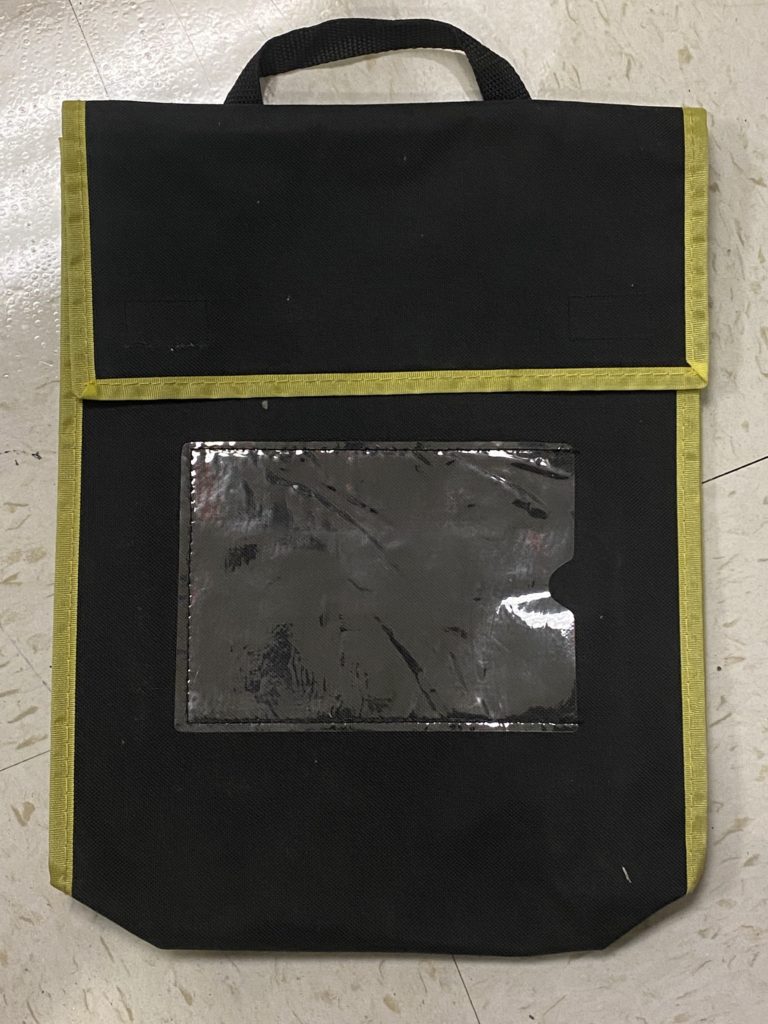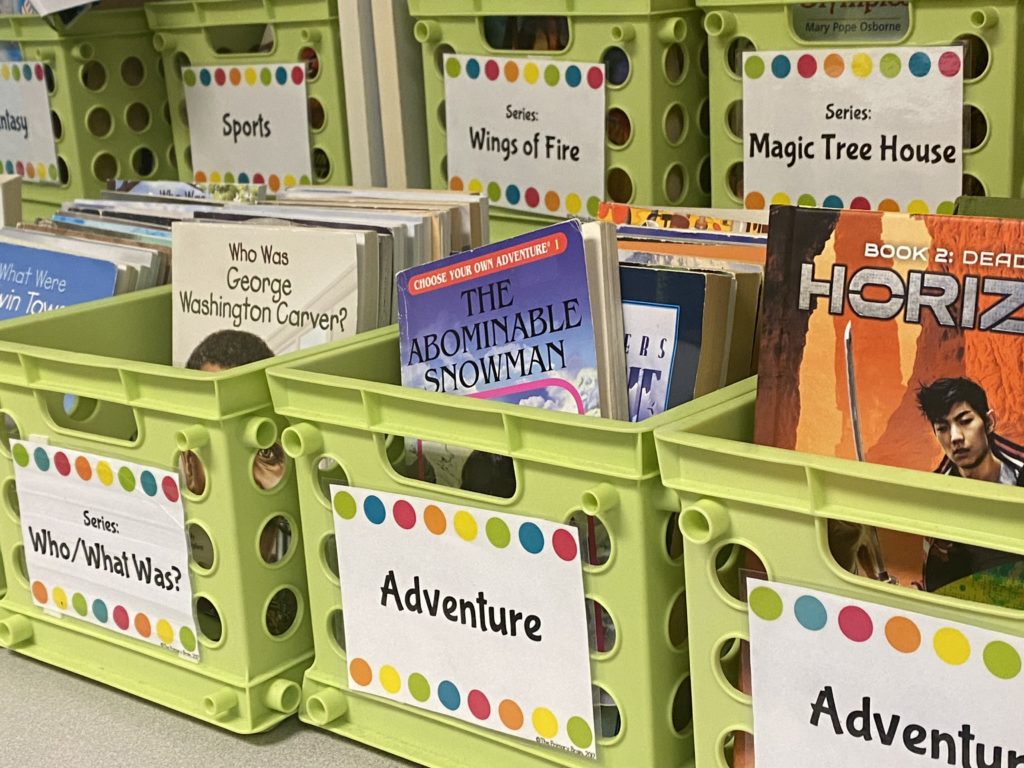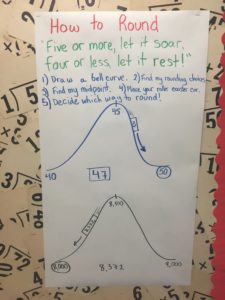Viewing: reading
September 6, 2022
Class Library, Book Bags, Math Mindset, and more!
In class today, after much anticipation, our class library opened for business! We spent a lot of time discussing how the library is organized, our routines for checking out and returning books, and much more! Students each received a black and yellow bag for bringing home (and returning to school) one or two books each night. This should come home nightly and should be returned the next day. In the next week or two, I will start sending home reading logs for kids to use to track their reading. (More on this in the coming weeks.) The kids were VERY excited to begin using our massive class library (which, I’m proud to say, offers well over 1,000 books)!
One of the students’ homework assignments this week is to build a list of between four and eight of their current favorite books. Families are welcome to help their kids, as I know it can help the fourth graders to have someone to remind them of books they’ve enjoyed. But students are welcome to complete this independently if they prefer. This is due Friday morning and will help us to kick off our efforts to build life-long readers.
Today, we launched our year of math by discussing the challenges I had with math as a child and by talking about the importance of a growth mindset. We watched an amazing video by Jo Boaler, a researcher and professor of math education, all about building sound and sustainable habits when working on math. The kids’ math homework is to share this video with a grown-up at home and to discuss it. The link is in their Google Classroom page, and as you watch the video, it will periodically pause to present a question/topic for you and your fourth grader to discuss. I know your schedules are very busy, so I’ve asked kids to finish it by Friday. If you would like the weekend to get it done, that’s no problem. Just send me a quick email.
One of the ideas presented in the video is about the relevance of grades. You’ll find that math assessments are one of the only worksamples that will come home with a percentage grade on it. I don’t like relying on percentages, because I think they give you an incomplete understanding of your child’s progress. Consider this scenario:
Imagine a class takes a 16 item assessment that is divided into four sections, each with four items. “Mary” gave one incorrect answer in each section, so she has a score of 12/16, or 75%. Because Mary correctly solved most of the problems in each section, I would consider her to be making “good progress,” despite 75% being seen by SOME as lack-luster score. Another student, “Bobby” also scored 12/16 (75%), but in his case, he had all four of his incorrect answers in a single section. This indicates that there was one area in which he needed more intensive review and support. Both kids received the same score of 75%, but their assessments yielded very different results.
This is just one example of the dangers of over-emphasizing the total score. When I review student work, I look at what they DO know, not what they DON’T know, and I ask you to do the same. I’ll write more about this before the first math assessment comes home, but here are a few highlights to consider as you talk about grades with your child while watching the video:
- Kids are more than test scores. So often, they base their self-image of how they’re doing on measurable metrics. They think that a good math grade means that they’re smart and good at math, and that a poor grade means they’re dumb and bad at the skill. This couldn’t be more wrong! I’ve seen outstanding students who struggle with test-taking or get overwhelmed by long assessments. (We work on these challenges together.)
- PLEASE, PLEASE, PLEASE do not set percentage goals for assessments. When students learn that 80% is the minimum acceptable grade, for example, it means that a 78% is a disaster. Surely two percentage points doesn’t make or break a child’s success in fourth grade. Instead, set behavioral goals, like “Answer each question fully, without skipping steps.” or “Check your work over to make sure your calculations are accurate.” or “Reread problems to make sure you correctly understood the question.” or “Draw the problem out to better understand it.” Grades are just one indicator of progress. They don’t solely indicate success or failure.
- When your child brings home work, start by looking for strengths. So often, we parents begin by quickly looking for the ink from a teacher’s pen to see where there were mistakes. But wouldn’t we rather see our kids’ successes? Reinforce the successes, rather than dwelling on the mistakes.
- When you do see mistakes or lost points, talk with your child about why it happened. Don’t blame, just reflect. Consider a math assessment in which your child got a 66%. I think we can all agree that we’d like our kids to do better. But think back to that example I offered above. This is a similar situation. Ask yourself: Was it a 66% because your student really struggled with one part of a concept, or was the challenge spread out more consistently? Even if the lost points were distributed throughout the assessment, think about what a 66% means. A student CORRECTLY answered 2/3 of the assessment to earn those points. Clearly he or she knows a lot about a concept to do that well to begin with, even if a 66% feels disappointing to us. Start with that mindset, and then work from there.
I hope this was helpful for you, and I look forward to talking more as the year continues! As always, feel free to reach out to me with any questions!
Posted in Class Updates|By Jon Moss
October 13, 2021
What have we been working on in reading?
In fourth grade, we kick off the year with a mini-unit focusing on the habits of reading. This includes how to choose a just-right book, why readers abandon books, how to discuss books, activities to build students’ reading stamina, and so much more. I want students to develop a life-long love of reading and to look at reading as an enjoyable hobby, not just as a requirement tied to school. We launched the year with these activities in order to provide students with a foundation for all of our other reading activities throughout the year. You’ll hear more from me, in the coming weeks, about your child’s “just right” reading level and how you can use that information to support his/her continued growth as a reader.
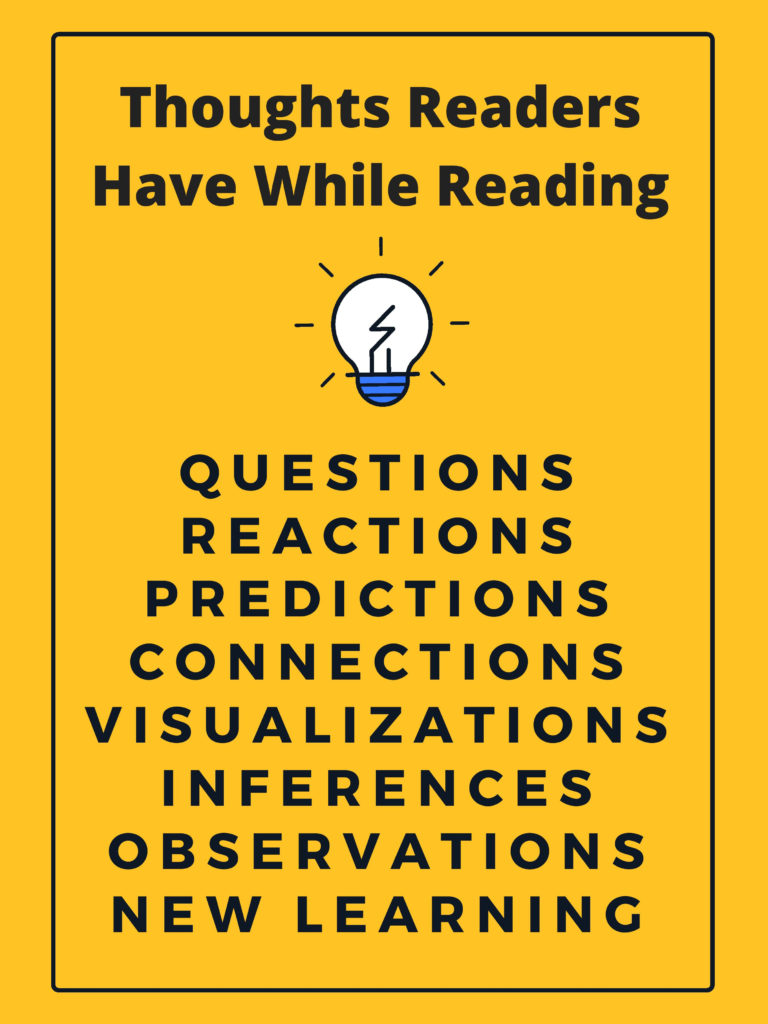
One of the best ways to grow as a reader is to discuss what you read. Throughout the year, this will be a focus. I want students to learn how to have conversations about what they read, beyond sharing factual information about the book and telling whether they like it or not. Over the years, I have kept track of the different kinds of thoughts readers have about their texts, and I narrowed them down to eight different categories. Listed in the graphic to the left, these ideas help us to make the idea of “Reading is Thinking” more concrete, and less of a nebulous “Gee… I’m supposed to think about… stuff… while I read!” Kids can focus their thinking in different categories, which can help to build these habits so the ideas come naturally as they grow and mature. Students are often encouraged to “stop and jot” while reading and to record some of their ideas on sticky notes, which then get placed in the book. (This is why we may go through sticky notes to quickly in class!) This can facilitate engaging discussions about books. Wondering how you can help your child? Use these eight types of thoughts to guide some of your reading discussions with your child. Rather than asking an open-ended question like “What did you think about _________?”, you can ask a more specific question using one of these eight types of thoughts. It can lead to a great conversation, especially when discussing connections.
With a lot of these foundational skills established, we’re now in the midst of our first core literacy unit. Students are learning about narrative elements (characters, settings, problems, main events, and solutions), and while these are hardly new concepts, they’re learning more sophisticated applications of these ideas. For example, where stories for younger kids have characters who are clearly “good” or “bad”, stories for upper elementary students tend to have more nuanced characters, with flawed protagonists or antagonists who still have redeeming qualities. Likewise, where stories for younger kids have a clearly defined problem and solution, stories for older children will start to have multiple problems and endings that may not solve problems as much as resolve challenges. As you read with your child, or as he or she reads independently, ask him/her questions about these different elements. (We’ve finished learning about the setting, and we’re now learning about characters. Next week, we will begin to work on identifying the problem in a story!
The start of the school year wouldn’t be complete without some reading assessments. This year, we’ve continued to use an assessment tool called aimswebPlus. aimswebPlus is an online tool that allows us to administer and score an oral reading assessment as well as reading comprehension tools. Starting this year, instead of giving students DRA assessments, we will use Benmark Assessments to help me to identify your child’s independent reading level, which will allow me to work with you to help your child to find just-right texts. Like DRAs, the Benchmark Assessments (often abbreviated as BAS) is giving individually to each student. It’s time consuming, but it’s well worth the time, as I’m getting to know your kids very well as readers.
In the next post, I’ll fill you in all about what we’re doing in writing! Enjoy your weekend!
Posted in Class Updates|By Jon Moss
October 23, 2020
Building Strong Reading Habits and Skills
In fourth grade, we kick off the year with a mini-unit focusing on the habits of reading. This includes how to choose a just-right book, why readers abandon books, how to discuss books, activities to build students’ reading stamina, and so much more. I want students to develop a life-long love of reading and to look at reading as an enjoyable hobby, not just as a requirement tied to school. We launched the year with these activities in order to provide students with a foundation for all of our other reading activities throughout the year. You’ll hear more from me, in the coming weeks, about your child’s “just right” reading level and how you can use that information to support his/her continued growth as a reader.

One of the best ways to grow as a reader is to discuss what you read. Throughout the year, this will be a focus. I want students to learn how to have conversations about what they read, beyond sharing factual information about the book and telling whether they like it or not. Over the years, I have kept track of the different kinds of thoughts readers have about their texts, and I narrowed them down to eight different categories. Listed in the graphic to the left, these ideas help us to make the idea of “Reading is Thinking” more concrete, and less of a nebulous “Gee… I’m supposed to think about… stuff… while I read!” Kids can focus their thinking in different categories, which can help to build these habits so the ideas come naturally as they grow and mature. Students are often encouraged to “stop and jot” while reading and to record some of their ideas on sticky notes, which then get placed in the book. (This is why we go through sticky notes to quickly in class!) This can facilitate engaging discussions about books. Wondering how you can help your child? Use these eight types of thoughts to guide some of your reading discussions with your child. Rather than asking an open-ended question like “What did you think about _________?”, you can ask a more specific question using one of these eight types of thoughts. It can lead to a great conversation, especially when discussing connections.
With a lot of these foundational skills established, we’re now in the midst of our first core literacy unit. Students are learning about narrative elements (characters, settings, problems, main events, and solutions), and while these are hardly new concepts, they’re learning more sophisticated applications of these ideas. For example, where stories for younger kids have characters who are clearly “good” or “bad”, stories for upper elementary students tend to have more nuanced characters, with flawed protagonists or antagonists who still have redeeming qualities. Likewise, where stories for younger kids have a clearly defined problem and solution, stories for older children will start to have multiple problems and endings that may not solve problems as much as resolve challenges. As you read with your child, or as he or she reads independently, ask him/her questions about these different elements. (We’ve finished learning about the setting, and we’re now learning about characters. Next week, we will begin to work on identifying the problem in a story!
The start of the school year wouldn’t be complete without some reading assessments. This year, we’ve started to use an assessment tool called aimswebPlus. aimswebPlus is an online tool that allows us to administer and score an oral reading assessment as well as reading comprehension tools. We are also continuing to give your students DRAs. DRAs (Developmental Reading Assessment) help me to identify your child’s independent reading level, which will allow me to work with you to help your child to find just-right texts. The process of giving DRAs (which are always given individually to students) is taking a bit longer than normal, because we (of course) couldn’t give these assessments in the springtime, so we’re doing some extra catch up. But it’s well worth the time, as I’m getting to know your kids very well as readers.
As valuable as the DRAs are, I also value getting information from reading conferences. In a reading conference, I sit with a student, invite them to read to me for a bit, and we discuss the story they’re reading. We always use whatever book they’re currently reading, so it’s a great opportunity to discuss reading interests, habits, and much more!
In the next post, I’ll fill you in all about what we’re doing in writing! Enjoy your weekend!
Posted in Class Updates|By Jon Moss
October 10, 2016
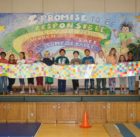
Why Read?
At a recent Town Meeting, our class shared many of our favorite reasons why we LOVE to read! Thanks for sharing your ideas! Take a look at the kids’ AMAZING work, below.
Posted in Class Updates|By Jon Moss
September 14, 2016
Day 9: What’s happening?
It feels as if we’ve been in school for many weeks! The students are doing a great job learning the routines of our class, and this has allowed us to move into our curriculum with efficiency and enthusiasm! Our first focus in reading has been discussing many of the strategies that successful readers use. We’ve discussed how readers choose books for themselves, why some readers abandon books, and how to use our class library. This afternoon, we’re going to again team up with Ms. Kelleher, our library-media specialist, to learn about how to choose a “Just Right” book for ourselves. This will be helpful as we find students’ independent reading levels in the coming weeks. Yesterday, we learned about how to “buzz”, that is, how to have a group conversation about a single topic. You might be surprised to hear that we’re focusing on something so fundamental, but we’ve found in fourth grade that dedicating time NOW to discussing the basic ideas of taking turns, making eye contact, etc. allows student discourse down the road to be significantly more productive and engaging.
In math, we’ve been working on place value! Our first few lessons introduced place value concepts and built upon the students’ prior skills. Today, we worked on rounding numbers; a concept that we’ll spread out over a few days. Estimation can be a challenging skill for students, so I teach them the roller coaster strategy. (See picture.) This method lets students break up the rounding process into five steps, and by adding a visual piece, it makes it less overwhelming for many learners. Feel free to show this image to your fourth grader to help them with their homework. Tomorrow, we’ll translate this strategy to a more traditional process in which they round numbers without the elaborate visual process. We’ll return to the roller coaster method when we work on rounding to different places, such as taking a number like 8,372 and rounding to the nearest thousand (8,000) or nearest hundred (8,400) or nearest ten (8,370). I don’t expect mastery on day one, and I admire the hard work students are showing!
We’ve started our Targeted Instruction rotations! As I explained at curriculum night, TI will allow us to meet each student’s individual needs by breaking up classes. For example, during the TI block one week, I might focus on rounding numbers, Mrs. Castle might focus on descriptive writing, and Miss Lacasse might focus on map skills. Rather than whole classes traveling together, we’ll each send our students to the teacher who is offering the activity that best fits student needs. We’re excited to have many different teachers collaborating with us, so stay tuned! This week, students ARE rotating among each teacher as whole classes in order to establish routines. Next week, we’re going to start to shuffle students.
Questions? Send me an email! Have a great day!
Posted in Class Updates|By Jon Moss
September 12, 2016
Video and Slides from Curriculum Night
Click here to download the PDF of my 2016-2017 Curriculum Night presentation!
Posted in Class Updates|By Jon Moss
March 22, 2014
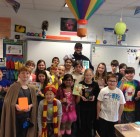
One School, One Book
This week, our school is finishing our first (annual, hopefully) One School, One Book activity. For the past few weeks, students throughout PGS have jointly read the first book of the According to Humphrey series. Each week, students read through a few chapters at home with their families, and on Fridays, as a whole school, we continued to read the book together. This particular book has been a great choice because it’s an easy enough book to be appropriate to read with kindergarteners, but it also has terrific opportunities for inferences and connections, making it a good fit for older students. Two weeks ago, PGS students dressed up as their favorite book characters, which was a fun way to celebrate many of our favorite books!
Posted in Class Updates|By Jon Moss
February 26, 2014

Working to Improve Reading Responses (Part 1)
Note from Jon: This is the first of (probably) three posts that address reading comprehension and critical response skills. This particular post is an updated version of a message I wrote three years ago on our class website. I know it’s long, but you might find it helpful!
One of the primary focuses of reading instruction is helping students to improve the quality of their short answer responses. Unlike multiple choice, true false, or fill-in-the-blank items in which there is a clear right answer, SAR tasks create situations in which students’ success hinges on the quality of their responses, not just their accuracy. I tend to find that there are three rules that often help students to be more successful when writing their own short answer responses:
- Always show the reader that you read and understood the story or article. PROVE IT!
- Always include some sort of textual support to explain your answer.
- Read the WHOLE question! Answer the WHOLE question!
Can you tell what the big trouble spots are? All three rules include the idea of needing to fully address the question by including relevant story details. Frequently, students lack the necessary supportive evidence from the text to reinforce their answer. As I often remind the students, any SAR question faced during reading has one main goal: To determine if the student understood and can interpret what he or she has read. If the student’s response lacks specific detail from the text, the reader has no way of measuring the student’s understanding. Take, for example, the following question and answer:
Question: What two questions would you ask the author of this article?
Answer: I would ask her why she chose to write about insects and what kind of insect is her favorite.
At face value, this response looks like it successfully answers the question – and in all fairness, it does. But while the question does not explicitly require students to integrate information from the article, this (fictional) student’s failure to do just that leaves us with a weak answer that does not show any understanding of the story. Both of the questions that the student suggested in his or her response show only a cursory understanding of the text: the story is about insects. There is no evidence of any in-depth understanding. This alternate response shows more in-depth comprehension by including details from the (pretend) article:
There are two questions that I would ask the author. First, I would ask her “Why are centipedes called centipedes if they can actually have between 20 and 300 legs?” Centi means “hundred,” so I would expect a centipede to have 100 legs. I would also ask “Are insects with exoskeletons larger than those with skeletons inside their bodies?” I’ve never seen a large insect before.
Notice a few particular strengths with this response. First, the student clearly wrote two questions – ending in question marks. (Yup, that matters!) Second, the student’s suggested questions include appropriately used terminology from the text (centipedes, exoskeletons) and concepts from the text (20-300 legs, meaning of centi, exoskeletons are outside the body). By including relevant details from the text, the student has shown that he or she is able to read and understand the text and that they can evaluate information in order to use the most relevant details as supportive evidence. This is a strong response.
This type of activity is hardly new. Students have been going “full-steam” on short answer responses since the start of third grade, if not earlier. Our expectations for short answer responses don’t change much from year to year, minimizing the “moving target” problem for kids. So why do some students continue to struggle? I see three possible causes:
- Some students are having a genuinely hard time. This describes the student who sees the question, thinks about what the best possible response could be, but for any number of reasons, he or she is not crafting successful responses. The student may not be struggling with the skill, per se, but he or she may simply have yet to master the grade-level expectations that go with the skill of writing a short answer response. I’m continuing to work with students on an ongoing basis to help them to strengthen their skills.
- Sadly, some students are unsuccessful because they simply did not carefully read the question being asked of them. Consider the two part question: “Do you agree with Laura’s decision at the end of the story? What advice would you give her so she could solve her problem without hurting Lester’s feelings?” A student could write an outstanding response about why they do or do not agree with Laura’s decision, citing lots of support from the text. But without addressing the second part of the question, the response falls short, and so will the score. Unfortunately, it’s not uncommon for responses to be more off-base than the example I’ve cited in this paragraph. Sometimes kids write an answer that may be well-crafted and thorough, but it may also be entirely irrelevant to the question asked, and again, points cannot be given.
- The most disappointing cause of difficulty is when students simply do not appear to be working with their best effort and focus. This is not a lack of understanding or mastery. Rather, in this situation, students may quickly write a cursory response that lacks detail or support because they chose not to work to their potential because, perhaps, they hurried through their work. These responses do not show a thorough understanding of the text, even though the student may truly have a high degree of comprehension. Convincing students of the need to put more thought and effort into their work is very challenging, because it’s a decision they need to make for themselves. No amount of prodding from you or from me will make it happen. Rather, they need to choose (hopefully with our help) that it’s time to bring their proverbial “A-game” to class. I’m bringing this up to you en masse for two reasons: First, I think that all students can benefit from a reminder about the importance of doing their best possible work. All of us, every now and then, fall short of this, so some helpful encouragement is valuable. Second, in some cases, I see this as a behavioral issue – if a student is choosing not to put in their best effort, despite having been reminded of the importance of doing so, they are not following directions and are not showing responsibility. That’s something I hope we can tackle together.
At the end of this week, your fourth grader will bring home his or her literacy binder for your to review over the weekend. In it, you will find several new work samples, many of which are short answer responses. As you review your child’s responses, look at their use of evidence and see how it influenced their score. (As a reminder, short answer responses are scored out of four possible points, with a goal of three points.) Conferences are coming up in a few weeks, and I look forward to talking with you more about this.
In my next post, I’ll share some strategies for how students can carefully select the most helpful textual evidence to support their responses.
Posted in Class Updates, Learning Resources, Reading|By Jon Moss

